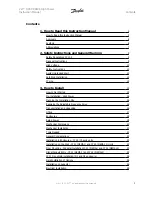
RIGOL
DG900 Programming Guide
2-89
All harmonic (ALL): the instrument outputs the fundamental waveform and all the orders of harmonics.
User-defined harmonic (USER): users can define the output orders of the harmonics, and the highest
order is 8.
The output states of the 8 orders of harmonics are represented by 8-bit binary data. The leftmost bit
represents the fundamental waveform; it is a fixed X and cannot be modified. The rest 7 bits
correspond to the second order of harmonic to the eighth order of harmonic from left to right. 1
denotes enabling the output of the corresponding order of harmonic, and 0 denotes disabling the
output of the corresponding order of harmonic. For example, set the 8-bit data to X0010001, which
denotes outputting the fundamental waveform, the fourth order of harmonic, and eighth order of
harmonic.
When [:SOURce[<n>]] or [<n>] is omitted, the system sets the related parameters of CH1 by default.
The actually output harmonic is limited by the currently specified highest order of harmonic
) and the harmonic type.
Return Format
The query returns EVEN, ODD, ALL, or USER.
Example
:SOUR1:HARM:TYP ODD /*Sets the harmonic type of CH1 to odd harmonic.*/
:SOUR1:HARM:TYP? /*Queries the harmonic type of CH1 and the query returns ODD.*/
[:SOURce[<n>]]:HARMonic:USER
Syntax
[:SOURce[<n>]]:HARMonic:USER <user>
[:SOURce[<n>]]:HARMonic:USER?
Description
Sets the user-defined harmonic output of the specified channel.
Queries the user-defined harmonic output of the specified channel.
Parameter
Name
Type
Range
Default
[<n>]
Discrete
1|2
1
<user>
ASCII String
X0000000 to X11111111
X0000000
Remarks
In the user-defined harmonic (
), users can define the output orders
of the harmonics, and the highest order is 8. The output states of the 8 orders of harmonics are
represented by 8-bit binary data. The leftmost bit represents the fundamental waveform; it is a fixed X
and cannot be modified. The rest 7 bits correspond to the second order of harmonic to the eighth
order of harmonic from left to right. 1 denotes enabling the output of the corresponding order of
harmonic, and 0 denotes disabling the output of the corresponding order of harmonic. For example,
set the 8-bit data to X0010001, which denotes outputting the fundamental waveform, the fourth order
of harmonic, and eighth order of harmonic.
When [:SOURce[<n>]] or [<n>] is omitted, the system sets the related parameters of CH1 by default.
Return Format
The query returns a string between X0000000 and X11111111. For example, X0010001.
Example
:SOUR1:HARM:USER X0010001 /*Sets the user-defined harmonic of CH1 to output the fundamental
waveform, fourth order of harmonic, and eighth order of harmonic.*/
:SOUR1:HARM:USER? /*Queries the user-defined harmonic output of CH1 and the query returns
X0010001.*/
Содержание DG952
Страница 2: ......
Страница 168: ......
Страница 181: ...Chapter 4 Programming Examples RIGOL DG900 Programming Guide 4 7 ...
Страница 185: ...Chapter 4 Programming Examples RIGOL DG900 Programming Guide 4 11 ...
Страница 187: ...Chapter 4 Programming Examples RIGOL DG900 Programming Guide 4 13 ...
Страница 199: ...Chapter 4 Programming Examples RIGOL DG900 Programming Guide 4 25 ...
Страница 200: ......
















































